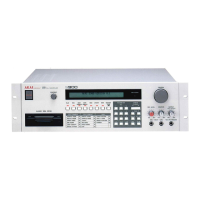20
^PAGE
09!
RESAMPLE,
DISCARD
(memory
savlngleatures)
-19
*R«sampl«
at half
bandwidth
(E
NT)
Discard
biftri
start.
after
and
(ENT)
RESAMPLE
Resample
at half
bandwidth
cuts the amount
of memory
used by
the
sample
in half,
but
also
reduces high
frequency
response
by
half.
1
.
Point
arrow
at "Resample
at half bandwidth."
Press
ENT.
2.
Sample
time will
be cut in half.
You can
continue
resampling
(although
quality will
deteriorate with
each
resample)
until
the
computer
runs
out of
patience.
Caution:
Resampling
erases
the original
sample. It
is
good prac-
tice
to make
a copy of
a
sample,
and
resample the
copy. If
you do
not
like the
results of
resampling,
you can always
go back
to the
original
sample.
DISCARD
Discard
eliminates
those
portions of the
sample
before
the
start
point and
after the
end
point. Since
you do not
hear
these
parts
of the
sample,
discarding
the
sample past
these
points will
save
memory.
Point
arrow
at "Discard
before start,
after end."
Press
ENT.
Caution: If
you intend to
alter the
start
or
end
point
at
some time
in the
future,
or think
you might,
do not
use discard.
IMPORTANT
INFORMATION
ABOUT
PAGES
10,11,
and 1
2
The
S900 can
also splice
two samples
(end of
one to
begin-
ning
of another)
or
mix
samples together.
For
example,
you
could
splice
the
sustain of
a piano on to
the
pluck
of a
guitar,
or
mix
bass and
guitar samples
together
to
create
an
octave
divider effect.
Splicing
involves
the
same
challenge
as looping
(i.e. finding
a
glitchiess
splice
point with no level
variations).
The
S900 cir-
cumvents this
problem
by
crossfading
between
the
two
sam-
ples
over a
specified number
of
samples.
1 st sample
2nd sample
Crossfade region
of splice
-
end
of
first
sample
transitions
smoothly
into
second
sample
PAGEIQJ SPLtCE
X-FADE
(select
samples
to
be
spliced, name new sample)
-1*
SPL
1 CE
•
2nd s a m
p
a name
iSAMPLE 2
X-FADE
New
s
am
p
« name
NEW SAMPLE
1
.
Select first sample to be spliced (or
mixed) on
PAGE 01
.
2. Select PAGE 10.
3. Point arrow
at "2nd sample name."
Rotate CONTROL
to scan
the available samples for splicing.
4. Point arrow
at
"New
sample name."
Name
(as
described
in
Chapter
2,
Part
1 )
the new sample that
will hold the
spliced
or
mixed samples. Press ENT after
naming.
PAGE
1
1
SPLICE CRO!
SS-FADE
TIME
-III
*Spl
c e
crossfade
(0-
8. 496)
tima,
(points)
i
000
1
.
The
lower left
side
of the
LCD shows the
available
number
of
sample points over
which
the
crossfade will
occur.
Point
arrow
at "Splice crossfade
time (points)."
2.
Use CONTROL
to
dial in the desired
crossfade
time, or enter
a five-digit
number with the
0—9
keys.
PAGE 1
2 SPLICE ORDER
-12 *SPLICE
ORDER: 1st then 2 r
d ( I
)
,
2nd then
1st
(2).
Together
(3). Mem
76K
1
.
To splice the
beginning of the
second sample
to the
end of
the
first sample, point arrow
at "SPLICE ORDER:"
and
press
1.
2. To
splice the
beginning of
the
first
sample to the
end
of the
second sample, point arrow
at "SPLICE ORDER:"
and
press
2.
3. To
mix the
two
samples together,
point arrow
at "SPLICE
ORDER:" and press 3.
Note that
the
LCD
displays the
remaining
amount
of
memory.
The
S900 may
not be
able to splice
for you if
there
is
less
memory left
than that of the
two samples combined.

